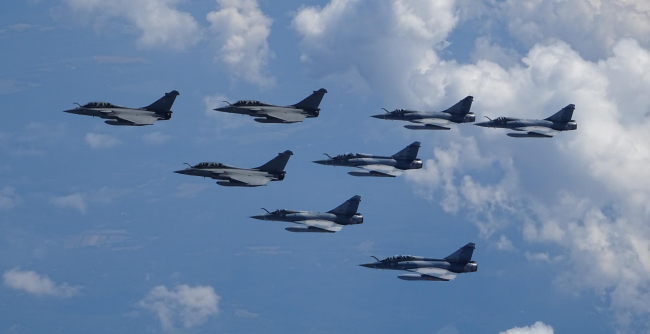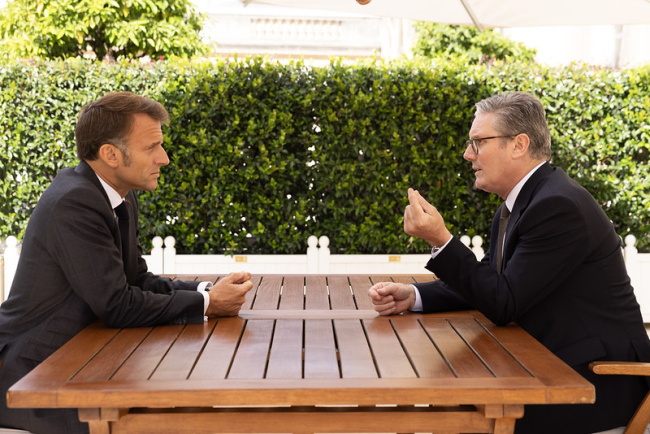The Future of Europe’s Strategic Deterrence is (also) at Sea
A cursory look at both France and the UK suggests that the future of European nuclear deterrence is at sea.

Strategic deterrence at sea has not been until recently a subject of significant public debate in Europe. Yet, the worrying prospect of the return to the White House of an isolationist and NATO-skeptic president combined with a major war being back in Europe, have brought back into the spotlight the long-standing debate about Eurodeterrence and the role of nuclear weapons in defending Europe.
Back in February 2020, French President Macron suggested that his country had to brainstorm the potential of a French contribution to the defense of Europe through its nuclear weapons. Indeed, he acknowledged – more clearly than his predecessors – that French vital interests had a “European dimension.” Macron’s observations should be understood in the context of the impact Brexit made about Britain’s contribution to the defense of the Europe in the context of the European Union security project. On the other hand, the British nuclear deterrence – centered on the country’s Ballistic Missile Submarines SSBNs – remains committed to NATO deterrence, thus serving a significant portion of EU countries that are also part of NATO.
Still, in light of a more contested age, this essay explores the role of strategic deterrence at sea in the transformation of the European security architecture. In particular the essay seeks to address the following two questions: how important is sea-borne deterrence to Europe? Is the future of European deterrence at sea?
Stealthy Statements: The Weapons Best Unseen
At first glance, SSBNs are not the obvious choice to demonstrate the contribution of French and British nuclear weapons to European defense. Inherently discreet and invisible thanks to nuclear propulsion, essential to maintain an effective nuclear deterrent at sea, they are much less practical for signaling reassurance.
It is difficult to imagine a French or UK SSBN making a port call in Gdansk due to the limited number of subs at sea at any given time. By contrast, the US, which, with 14 SSBNs, can indeed invest in political signaling through SSBNs by having them making calls in a port in South Korea to manifest U.S. support to its arrangements with the country.
By a similar token, it is worth recalling that NATO nuclear exercises are, for example, centered on the air component of nuclear deterrence, with many air forces contributing to the yearly strategic exercise Steadfast Noon. Similarly, the quarterly exercise “Poker” of the French strategic air force focuses on air-borne nuclear weapons.
Additionally, U.S. extended deterrence to NATO is partly demonstrated through nuclear sharing arrangements, especially the deployment of B-61 nuclear gravity bombs that can be carried by dual-capable aircraft. Apart from strategic signaling, air-borne nuclear weapons are also considered to add some degree of flexibility in the context of limited nuclear strike when intended to prevent nuclear escalation. This would seemingly be the case both in NATO and French doctrine (ultime avertissement).
Important Statements: Deterrence and Strategic Signaling
On the other hand, permanent at sea deterrence remains the bedrock of nuclear doctrine for Britain which focused on strategic deterrence through second strike capabilities. In Britain, strategic deterrence is the ultimate insurance policy, more than a tactical option in the sense of limited strike. The focus is on the survivability of SSBNs, and thus their credibility for reassurance to national constituencies and European allies.
Such a posture still allows to offer strategic signaling with SSBNs. For instance, according to French media, France deployed three out of its four SSBNs in early March 2022 to respond to the aggressive nuclear rhetoric of President Putin. Visits by foreign leaders to SSBN bases always have an effect, at quite a low cost. Also, testing a missile, like the M51 from an SSBN, can serve a similar purpose. In this respect, the opposite is also true, and the recent failures of a Trident tests conducted by the UK invited questions about the importance to conduct such tests more frequently to avoid the erosion of the broader reassurance and strategic signaling value.
Further, in an age of increased military contestation at sea, the sensitivity around the management of SSBNs and their nuclear deterrence mission create a demand for the navies possessing such capabilities of the highest levels of professional standards.
For example, at sea deterrence based on SSBNs rests at the heart of the French navy. This, in turn, invites a considerable attention to the highest technical and seamanship standards, thus inviting an ambition to enhance the overall efficiency of the Navy. Such demands contribute to the credibility of deterrence globally.
In Europe, French SSNs patrolling around Faslane – or joining respective national exercises – are also a good sign of cooperation between the UK and France, and can be perceived as reassuring by other European nations. Last but by no means least, a unique aspect of the French approach to nuclear deterrence is the Force aéronavale nucléaire (naval nuclear air force), composed of Rafale Marine capable operated from the aircraft carrier Charles de Gaulle, carrying part of the French strategic cruise missiles, assembled onboard with crucial components stored in secure hangars. Whilst their operational credibility can be debated, it is undoubtedly a strong additional signal that France can use to deter its enemies and reassure its allies.
The future of strategic deterrence at sea: remaining strong and persistent
Is the future of European deterrence at sea? A cursory look at both France and the UK suggests that the answer is a resounding yes. As such, how can the sea be better included as a future theater of European – nuclear – deterrence?
First, both navies’ budgets must be protected, and a much greater effort is needed to meet deadlines and indeed potential industrial constraints. France is on track for the next generation of SSBNs. In the UK, the AUKUS agreement, the trilateral pact with the United States and Australia to provide the latter with nuclear-powered submarines, is creating the conditions for the country to expand its overall national endeavour to nuclear-powered submarines. On the other hand, shipyards remain under pressure as they will need to deliver the next generation of SSBNs on schedule (Dreadnought) to meet the subsequent deadlines for the next generation SSN-AUKUS.
Second, as the demand for strategic deterrence in Europe remains high, so should the capacity to maintain fleets of relevant size and capabilities. Strategic deterrents at sea work best when part of a broader fleet balance in which conventional ships facilitate the coordination between conventional forces and nuclear missions, a practice already familiar to the UK but less so to France, despite some recent debates on épaulement.
Additionally, more efforts could be made to enhance strategic signaling through SSBNs, such as more visits of foreign leaders on UK and French ships and even long-term internships of foreign naval officers on nuclear ships – perhaps starting with nuclear attack submarines (SSNs) to respect confidentiality and ultimately SSBNs. Finally, clearer commitments from France and the UK regarding the European dimension of their nuclear arsenals could be expressed, for example, with a renewed Ottawa declaration, opening debates about this role in the French Parliament, and perhaps a greater French contribution to NATO nuclear exercises, with a larger naval dimension. What remains certain is that strategic deterrence at sea is likely to remain a central pillar, and increasingly more so, of the current reshaping of the European security architecture.
> Read the article on ISPI's website.

Available in:
Regions and themes
Share
Related centers and programs
Discover our other research centers and programsFind out more
Discover all our analysesSaudi Arabia’s Nuclear Temptations. Lessons Learned from Regional Instability
Saudi Arabia’s integration in the international arena and regional stability, notably through reducing its dependence on fossil energies, are crucial elements for the success of the Kingdom’s Vision 2030, the Crown Prince’s top priority. However, Mohammed bin Salman’s declarations in 2018 and 2021, indicating that “if Iran develops a nuclear bomb, we will follow suit as soon as possible”, combined with the recent strikes on key Iranian nuclear facilities, do not bode well for the future of the Kingdom, the region and the non-proliferation regime at large.
The Future of Air Superiority. Command of the Air in High Intensity Warfare
Air superiority, understood as control of the air, is a cornerstone of the Western art of warfare. It is a decisive condition, albeit not sufficient by itself, to achieve military victory, as it enables the concentration of air power toward the achievement of wider strategic objectives and protects other components from unbearable attrition levels. It is best achieved through the offensive use of air power in a joint effort to neutralize the enemy’s air power.
Europe Uncovered?
As Russia continues to threaten Europe, the Trump administration is making no secret of its desire to withdraw—at least partially—from the defense of the Old
Continent in order to focus on strategic competition with China. It is thus putting pressure on its European allies to increase their investment in the military sector. The NATO Summit in The Hague in June 2025 resulted in ambitious commitments by member states to increase their defense spending.
How should Britain and France cooperate to realise the Northwood Declaration?
During his state visit to the United Kingdom (UK) last week, Emmanuel Macron, President of France, signed a joint declaration with Sir Keir Starmer, Prime Minister, on nuclear cooperation between Britain and France. The Northwood Declaration highlights that while both countries’ nuclear arsenals remain sovereign, cooperation on nuclear deterrence can ‘contribute significantly’ to the security of the North Atlantic Treaty Organisation (NATO) and the Euro-Atlantic region.











